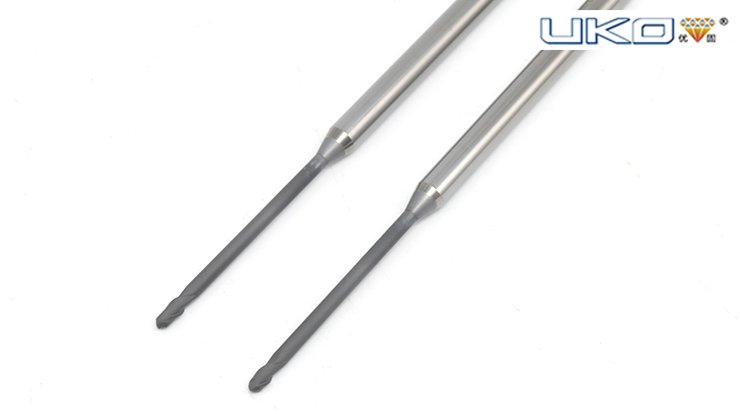
The ball end milling cutter is a tool with a blade similar to a ball end and assembled on a milling machine for milling various curved surfaces and arc grooves. Ball end milling cutter is also called R cutter. It is mainly used for cavity processing, bevel, forming, and profiling processing. When in use, the use of the tool tip to process the workpiece should be minimized, because at the position of the tool tip of the ball-end cutter, the processing line speed is 0 during actual processing, that is to say, the tool is not actually cutting, but is grinding. Its applications include automotive, aviation, aerospace, electronics, instrumentation, machinery manufacturing and other industries.
CVD diamond ball nose end mill is a kind of milling cutter using CVD diamond coating, its cutting effect is very good, and it can be used to process various materials, such as aluminum, copper, plastic, FRP, etc. The advantages of diamond ball end mills are good wear resistance, long service life, and not easy to produce burrs.
The reason for why CVD diamond-coated ball end mills generally use CVD coatings instead of PVD coatings, mainly because the advantages of CVD coatings are more prominent. The advantages of CVD coating include: high hardness and strength, good thermal stability, good wear resistance, stable chemical properties, low friction coefficient, compact structure, etc. In contrast, the advantages of PVD coatings are mainly low-temperature deposition and the compressive stress state inside the film, which is more suitable for coating precision and complex carbide tools, and the PVD process is pollution-free, enabling green manufacturing.
Advantages of using ball end milling cutter
A more stable processing state can be obtained: when using a ball-end cutter for processing, the cutting angle is continuously changing, and there is almost no sudden change. In this way, the change of cutting force is also a continuous change process, so that the cutting can be guaranteed during processing. The state is more stable and the surface finish is higher.
The ball-end cutter is an ideal tool for semi-finishing and finishing of curved surfaces: the spindle motor we use has poorer ability to resist axial force, so generally the ball-end cutter cannot be used for rough machining, but in semi-finishing Among them, it is very good to use a ball nose knife. After using the ball end cutter for semi-finishing, there will be less machining residue, which is more conducive to the following finishing process. The path spacing of semi-finishing is generally two times the spacing of finishing machining. If the method of parallel section is used, it is better to be 90 degrees to the direction of finishing machining.
The actual cutting radius is reduced: just like using the bullnose cutter, the use of the ball nose cutter reduces the actual cutting diameter, reduces the cutting line speed, reduces the cutting power and cutting torque during cutting, and is more conducive to the spindle motor Work in better condition.
Problems that should be paid attention to in the use of ball end milling cutter
- Minimize the use of the tool tip to process the workpiece: at the position of the tool tip of the ball-end cutter, the processing line speed is 0 during actual processing, that is to say, the tool is not actually cutting, but grinding. During processing, the coolant cannot be added to the cutting area at all, which will lead to a relatively large cutting heat and a decrease in tool life.
- For the straight wall, it is best to use the contour processing method for processing: it is necessary to minimize the phenomenon that the ball-end cutter processes downward along the straight wall. Relatively speaking, it is a very good method to process upwards along the straight wall, but it is difficult to separate them in actual processing. Let’s compare the difference between the two.
- The phenomenon of downward machining can be reduced by using the contour shape to process the straight wall. If you can use the phenomenon of “feeding the knife from the bottom up”, it can be avoided. When using “feeding from bottom to top”, you must first consider whether the cutting capacity of the milling cutter is too large. If there is a relatively large residual material at the root of the curved surface after the upper part is processed, the processing capacity of the end mill may be too large. . This does not protect the knife but destroys the knife.
- Pay attention to the processing of deep grooves with ball end milling cutters: when processing deep grooves, the tool may sink completely. Since the chip pocket of the ball end milling cutter is relatively small, when processing sticky materials (such as copper), the feed When the speed is fast, it is easy to break the knife. Therefore, when using a ball-end cutter for processing, attention should be paid to chip removal.
Hope this article can help you on the cnc machining. Any question, please contact Melody!